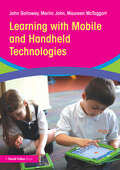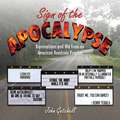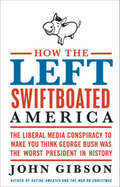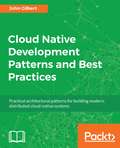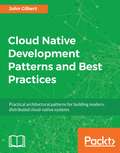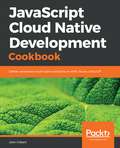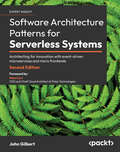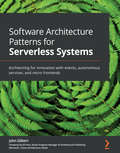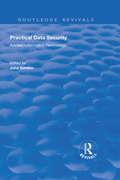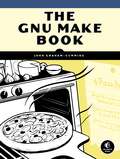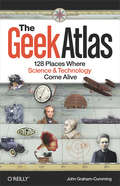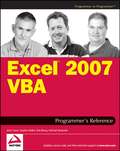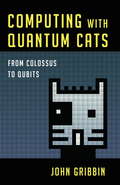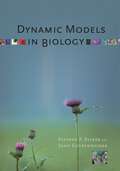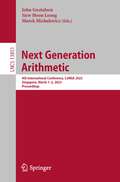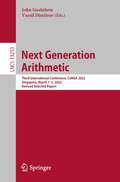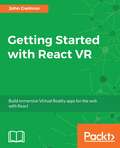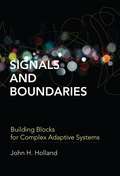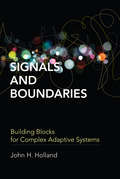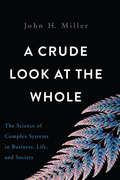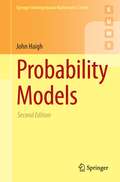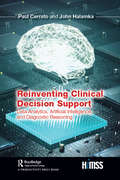- Table View
- List View
Information Systems: A Manager's Guide to Harnessing Technology, Version 3.0
by John GallaugherWHAT'S NEW IN 3.0:<P><P> UPDATED, MORE RELEVANT INFORMATION:<P> New coverage including Uber, WhatsApp, Facebook, and bitcoin breathes fresh life into existing material. The popular Zara and Netflix case studies remain but contain refreshed information.<P> EMPHASIS ON SOCIAL MEDIA:<P> Instagram, SnapChat, WhatsApp, Tinder, Secret, and Whisper all receive mention, ensuring relevancy and proper understanding of the current field.<P> MOBILE VS. DESKTOP:<P> In a number of renamed chapters, Gallaugher weighs the pros and cons of social media use on desktop computers and mobile devices, prompting classroom dialogue surrounding the rise of different technologies and how businesses and managers adjust to emerging trends.<P> DISCUSSION OF THE SHARING ECONOMY:<P> With the addition of an entirely new chapter focused on the sharing economy, Gallaugher introduces examples of citizens coming together to create or share resources across markets.<P> For a comprehensive list of what's new in version 3.0, visit Gallaugher’s blog.<P> John Gallaugher of Boston College was one of BusinessWeek’s “Professors of the Year.” His widely popular textbook offers a proven approach that has garnered student praise and increased information systems enrollment. There is no other Information Systems author today who keeps his text as "up-to-the-month" current. <P> For regular updates, follow Gallaugher’s blog, The Week in Geek, and connect with him on Twitter at @gallaugher.<P> This textbook is suitable for these courses:Undergraduate or graduate courses in Management Information Systems and Information Technology<P> This textbook is suitable for 2 and 4 year institutions.<P> PEDAGOGICAL FEATURES:<P> FOCUS ON STRATEGIC THINKING:<P> Rather than lead with technical topics, the book starts with strategic thinking, focusing on big-picture issues that have confounded experts but will engage students.<P> ENGAGING CASE STUDIES:<P> While chapters introduce concepts, cases on approachable, exciting firms across industries further challenge students to apply what they've learned.<P> CUSTOMIZABILITY:<P> The Flat World Knowledge publishing model allows instructors to adapt the textbook to the exact needs of their specific class and student body. <P>
Information Systems: A Manager's Guide to Harnessing Technology, v. 5.0
by John GallaugherWHAT'S NEW IN 5.0:<P><P> FRESHLY UPDATED:<P> Every chapter has received an update to ensure that it covers the latest topics and material. Today’s cutting edge firms and headline grabbing topics are presented through durable frameworks and concepts.<P> WORLDWIDE TRENDS IN TECH DEVELOPMENTS:<P> Included are updates and statistics on companies and technologies being developed around the world. China started the century as a nation largely unplugged and offline, but now has more internet users than any other country. In Sub-Saharan Africa, 70% of the population lives within mobile cell phone coverage. Now, even drones are affordable enough to be used as a delivery system in places with poor infrastructure.<P> PROTEUS, A PILL CAMERA:<P> A mini-case in the “Moore’s Law and More” chapter discusses the launch of Proteus’s low cost and efficient “PillCam.” Using small sensors and powered by digestive acids, the pill allows doctors to see a unique perspective inside the human body (literally).<P> SOCIAL MEDIA POWERHOUSE:<P> Statistics on the massive amount of new social networks and acquisitions in the marketplace have all been updated. New content includes Microsoft’s acquisition of LinkedIn, Slack’s dominant presence in the business space, and the rise of companies like HubSpot. New subsections discuss Twitter and the rise of microblogging, as well as Facebook’s dominant news feed and its strong position against Google’s advertising monopoly.<P> CUTTING EDGE COVERAGE:<P> From Facebook’s move to make Messenger a platform to Google’s evolution to Alphabet, students will feel their text and classroom are alive with the most current content available.<P> For a comprehensive list of what's new in version 5.0, visit Gallaugher’s blog.<P> John Gallaugher of Boston College has been named one of Entrepreneur Magazine’s “Gurus to Grads.” His popular and award-winning textbook offers a proven approach that has garnered student praise and increased information systems enrollment. Each year Gallaugher meets with scores of tech industry executives from Silicon Valley to sub-Saharan Africa, and there is no other Information Systems author today who keeps his text as "up-to-the-month" current. <P> For regular updates, follow Gallaugher’s blog, The Week in Geek, and connect with him on Twitter at @gallaugher.<P> This textbook is suitable for these courses:Undergraduate or graduate courses in Management Information Systems and Information Technology<P> This textbook is suitable for 2 and 4 year institutions.<P> PEDAGOGICAL FEATURES:<P> FOCUS ON STRATEGIC THINKING:<P> Rather than lead with technical topics, the book starts with strategic thinking, focusing on big-picture issues that have confounded experts but will engage students.<P> CURRENT, ENGAGING AND HOLISTIC CASE STUDIES:<P> While chapters introduce concepts, cases on approachable, exciting firms across industries further challenge students to apply what they've learned. Students love how concepts are introduced in a text that reads more like Wired and the Wall Street Journal than a conventional textbook.<P> CONCEPTS:<P> Chapters cover not only strategy and technology basics, but critical and cutting edge concepts such as data analytics, security, social media, the sharing economy, disruptive innovation, network effects and platform creation, open source, and cloud computing.<P> FASCINATING FIRMS:<P> In-depth profiles include firms that students know and are eager to learn more about. Amazon, Facebook, Google, Netflix, Rent the Runway, and Zara are among the firms that get extended coverage, along with mini-cases on Airbnb, Uber, and more.<P> CUSTOMIZABILITY:<P> The Flat World Knowledge publishing model allows instructors to adapt the textbook to the exact needs of their specific class and student body. See how easy it is to customize a textbook in this 4 minute demo: Flat World Editing Platform Video Demo
Information Systems: A Manager’s Guide to Harnessing Technology
by John GallaugherThe text offers a proven approach that has garnered student praise, increased IS enrollment, and engaged students to think deeper and more practically about the space where business and technology meet. Every topic is related to specific business examples, so students gain an immediate appreciation of its importance. Rather than lead with technical topics, the book starts with strategic thinking, focusing on big-picture issues that have confounded experts but will engage students. And while chapters introduce concepts, cases on approachable, exciting firms across industries further challenge students to apply what they've learned, asking questions like: Why was NetFlix able to repel Blockbuster and WalMart? How did Harrah's Casino's become twice as profitable as comparably-sized Caesar's, enabling the former to acquire the latter? How does Spain's fashion giant Zara, a firm that shuns the sort of offshore manufacturing used by every other popular clothing chain, offer cheap fashions that fly off the shelves, all while achieving growth rates and profit margins that put Gap to shame? What's an IPO and can a technology alternative push out investment bankers and insiders to the benefit of entrepreneurs and small investors? Why is Google more profitable than Disney? Is Facebook really worth $15 billion?
Learning with Mobile and Handheld Technologies: Inside And Outside The Classroom
by John Galloway Merlin John Maureen McTaggartAs technology evolves we are ever more reliant on the use of handheld and mobile devices, yet what do we know about their impact on learning? While there is a lot of interest in mobile technology, many schools still aren’t sure how to best use it for learning and teaching. Learning with Handhelds and Mobiles explores this landscape and offers examples of how these technologies have been used for learning, how the problems that have arisen are being addressed, and offers ideas for the future. This invaluable book gives a voice to teachers and educators using mobiles and technology-enhanced learning in and out of schools, for regular school work and for innovative projects through exciting partnerships like Apps for Good. Learning with Handhelds and Mobiles shows the changes that are taking place within schools as a direct result of these emerging technologies, and contains case studies with accounts of best practice in a variety of settings including primary, secondary, and special schools, and learning beyond their boundaries. The book also explores themes of pedagogy, communication and affordances, collaborative learning, individual creativity and expression, self-directed and informal learning and outdoor education. The learning potential of handheld and mobile devices has excited teachers and educators, but until now there has been no structured, systematic overview available along with reflections on how this technology is changing educational practice. This book brings these together to provide a clearer picture of what is currently a fragmented area, and offers expert views of how we can understand these, and where it may take us next.
Sign of the Apocalypse: Ruminations and Wit from an American Roadside Prophet
by John GetchellFriends, neighbors, and passersby from all over the country can’t fail to miss “The Sign’s constantly changing humor and insight. On occasion, The Sign of the Apocalypse (SOTA) traffics in the earnest, but at its heart is rooted in a deep-seated desire to express the sarcastic and snort-worthy. This, and a love of haiku, pizza, Latin, double entendre, and the worst puns ever crafted. Two years in the making, the message on “The Sign” is changed on a daily basis, with the primary benefit of slowing passing traffic to a honking crawl. It was designed to convey pithy tidbits of thought and wordplay. In its conception, SOTA was perpetrated in spite of the objection of the author's girlfriend, and with hopes of creating controversy and dismay in the local community. The girlfriend packed up and left, and the community and town fathers were surprisingly gruntled by the proceedings. Punny and sarcastic signs include: • When attacked by a gang of clowns, go for the juggler • What if doing the hokey pokey really is what it’s all about? • Legalize marinara • A penny saved is ridiculous • Wendy, please take me back / I’m so miserable / it’s almost like / you’re still here
How the Left Swiftboated America: The Liberal Media Conspiracy to Make You Think George Bush Was the Worst President in History
by John GibsonIn How the Left Swiftboated America, FOX commentator and bestselling author John Gibson offers the first comprehensive defense of the Bush presidency against its numerous detractors. In this provocative political work, Gibson explores who was right and who was wrong in taking us into the Iraq War and a host of other issues, arguing that it was the Left that actually lied while claiming to expose the truth.
Cloud Native Development Patterns and Best Practices: Practical Architectural Patterns For Building Modern, Distributed Cloud-native Systems
by John Gilbert<P><P>Learn to apply cloud-native patterns and practices to deliver responsive, resilient, elastic, and message-driven systems with confidence <P><P>Key Features <P><P>Understand the architectural patterns involved in cloud-native architectures <P><P>Minimize risk by evolving your monolithic applications into distributed cloud-native systems <P><P>Discover best practices for applying cloud-native patterns to your enterprise-level cloud applications <P><P>Book Description <P><P>Build systems that leverage the benefits of the cloud and applications faster than ever before with cloud-native development. This book focuses on architectural patterns for building highly scalable cloud-native systems. You will learn how the combination of cloud, reactive principles, devops, and automation enable teams to continuously deliver innovation with confidence. <P><P>Begin by learning the core concepts that make these systems unique. You will explore foundational patterns that turn your database inside out to achieve massive scalability with cloud-native databases. You will also learn how to continuously deliver production code with confidence by shifting deployment and testing all the way to the left and implementing continuous observability in production. There's more-you will also learn how to strangle your monolith and design an evolving cloud-native system. <P><P>By the end of the book, you will have the ability to create modern cloud-native systems. <P><P>What you will learn <P><P>Enable massive scaling by turning your database inside out <P><P>Unleash flexibility via event streaming <P><P>Leverage polyglot persistence and cloud-native databases <P><P>Embrace modern continuous delivery and testing techniques <P><P>Minimize risk by evolving your monoliths to cloud-native <P><P>Apply cloud-native patterns and solve major architectural problems in cloud environment <P><P>Who This Book Is For <P><P>This book is for developers who would like to progress into building cloud-native systems and are keen to learn the patterns involved. Basic knowledge of programming and cloud computing is required.
Cloud Native Development Patterns and Best Practices: Practical architectural patterns for building modern, distributed cloud-native systems
by John GilbertLearn to apply cloud-native patterns and practices to deliver responsive, resilient, elastic, and message-driven systems with confidence Key Features Understand the architectural patterns involved in cloud-native architectures Minimize risk by evolving your monolithic applications into distributed cloud-native systems Discover best practices for applying cloud-native patterns to your enterprise-level cloud applications Book Description Build systems that leverage the benefits of the cloud and applications faster than ever before with cloud-native development. This book focuses on architectural patterns for building highly scalable cloud-native systems. You will learn how the combination of cloud, reactive principles, devops, and automation enable teams to continuously deliver innovation with confidence. Begin by learning the core concepts that make these systems unique. You will explore foundational patterns that turn your database inside out to achieve massive scalability with cloud-native databases. You will also learn how to continuously deliver production code with confidence by shifting deployment and testing all the way to the left and implementing continuous observability in production. There's more—you will also learn how to strangle your monolith and design an evolving cloud-native system. By the end of the book, you will have the ability to create modern cloud-native systems. What you will learn Enable massive scaling by turning your database inside out Unleash flexibility via event streaming Leverage polyglot persistence and cloud-native databases Embrace modern continuous delivery and testing techniques Minimize risk by evolving your monoliths to cloud-native Apply cloud-native patterns and solve major architectural problems in cloud environment Who this book is for This book is for developers who would like to progress into building cloud-native systems and are keen to learn the patterns involved. Basic knowledge of programming and cloud computing is required.
JavaScript Cloud Native Development Cookbook: Deliver serverless cloud-native solutions on AWS, Azure, and GCP
by John GilbertMaster over 60 recipes to help you deliver completely scalable and serverless cloud-native applicationsKey FeaturesDevelop global scale and event-driven autonomous servicesContinuously deploy, test, observe, and optimize your servicesPractical Node.js recipes for serverless cloud-native developmentBook DescriptionCloud-native development is a modern approach to building and running applications that leverages the merits of the cloud computing model. With cloud-native development, teams can deliver faster and in a more lean and agile manner as compared to traditional approaches. This recipe-based guide provides quick solutions for your cloud-native applications.Beginning with a brief introduction, JavaScript Cloud-Native Development Cookbook guides you in building and deploying serverless, event-driven, cloud-native microservices on AWS with Node.js. You'll then move on to the fundamental patterns of developing autonomous cloud-native services and understand the tools and techniques involved in creating globally scalable, highly available, and resilient cloud-native applications. The book also covers multi-regional deployments and leveraging the edge of the cloud to maximize responsiveness, resilience, and elasticity.In the latter chapters you'll explore techniques for building fully automated, continuous deployment pipelines and gain insights into polyglot cloud-native development on popular cloud platforms such as Azure and Google Cloud Platform (GCP). By the end of the book, you'll be able to apply these skills to build powerful cloud-native solutions.What you will learnImplement patterns such as Event Streaming, CQRS, and Event SourcingDeploy multi-regional, multi-master solutionsSecure your cloud-native services with OAuth and OpenID ConnectCreate a robust cloud-native continuous deployment pipelineRun services on AWS, Azure, and GCPImplement autonomous services to limit the impact of failuresWho this book is forIf you want to develop powerful serverless, cloud-native solutions, this book is for you. You are expected to have basic knowledge of concepts of microservices and hands-on experience with Node.js to understand the recipes in this book.
Software Architecture Patterns for Serverless Systems: Architecting for innovation with event-driven microservices and micro frontends
by John GilbertDelve into the second edition to master serverless proficiency and explore new chapters on security techniques, multi-regional deployment, and optimizing observability.Key FeaturesGain insights from a seasoned CTO on best practices for designing enterprise-grade software systemsDeepen your understanding of system reliability, maintainability, observability, and scalability with real-world examplesElevate your skills with software design patterns and architectural concepts, including securing in-depth and running in multiple regionsBook DescriptionOrganizations undergoing digital transformation rely on IT professionals to design systems to keep up with the rate of change while maintaining stability. With this edition, enriched with more real-world examples, you’ll be perfectly equipped to architect the future for unparalleled innovation. This book guides through the architectural patterns that power enterprise-grade software systems while exploring key architectural elements (such as events-driven microservices, and micro frontends) and learning how to implement anti-fragile systems. First, you'll divide up a system and define boundaries so that your teams can work autonomously and accelerate innovation. You'll cover the low-level event and data patterns that support the entire architecture while getting up and running with the different autonomous service design patterns. This edition is tailored with several new topics on security, observability, and multi-regional deployment. It focuses on best practices for security, reliability, testability, observability, and performance. You'll be exploring the methodologies of continuous experimentation, deployment, and delivery before delving into some final thoughts on how to start making progress. By the end of this book, you'll be able to architect your own event-driven, serverless systems that are ready to adapt and change.What you will learnExplore architectural patterns to create anti-fragile systemsFocus on DevSecOps practices that empower self-sufficient, full-stack teamsApply microservices principles to the frontendDiscover how SOLID principles apply to software and database architectureGain practical skills in deploying, securing, and optimizing serverless architecturesDeploy a multi-regional system and explore the strangler pattern for migrating legacy systemsMaster techniques for collecting and utilizing metrics, including RUM, Synthetics, and Anomaly detectionWho this book is forThis book is for software architects who want to learn more about different software design patterns and best practices. This isn't a beginner's manual – you'll need an intermediate level of programming proficiency and software design experience to get started.You'll get the most out of this software design book if you already know the basics of the cloud, but it isn't a prerequisite.
Software Architecture Patterns for Serverless Systems: Architecting for innovation with events, autonomous services, and micro frontends
by John GilbertA professional's guide to solving complex problems while designing modern softwareKey FeaturesLearn best practices for designing enterprise-grade software systemsUnderstand the importance of building reliable, maintainable, and scalable systemsBecome a professional software architect by learning the most effective software design patterns and architectural conceptsBook DescriptionAs businesses are undergoing a digital transformation to keep up with competition, it is now more important than ever for IT professionals to design systems to keep up with the rate of change while maintaining stability. This book takes you through the architectural patterns that power enterprise-grade software systems and the key architectural elements that enable change such as events, autonomous services, and micro frontends, along with demonstrating how to implement and operate anti-fragile systems. You'll divide up a system and define boundaries so that teams can work autonomously and accelerate the pace of innovation. The book also covers low-level event and data patterns that support the entire architecture, while getting you up and running with the different autonomous service design patterns. As you progress, you'll focus on best practices for security, reliability, testability, observability, and performance. Finally, the book combines all that you've learned, explaining the methodologies of continuous experimentation, deployment, and delivery before providing you with some final thoughts on how to start making progress. By the end of this book, you'll be able to architect your own event-driven, serverless systems that are ready to adapt and change so that you can deliver value at the pace needed by your business.What you will learnExplore architectural patterns to create anti-fragile systems that thrive with changeFocus on DevOps practices that empower self-sufficient, full-stack teamsBuild enterprise-scale serverless systemsApply microservices principles to the frontendDiscover how SOLID principles apply to software and database architectureCreate event stream processors that power the event sourcing and CQRS patternDeploy a multi-regional system, including regional health checks, latency-based routing, and replicationExplore the Strangler pattern for migrating legacy systems Who this book is forThis book is for software architects and aspiring software architects who want to learn about different patterns and best practices to design better software. Intermediate-level experience in software development and design is required. Beginner-level knowledge of the cloud will also help you get the most out of this software design book.
Practical Data Security (Routledge Revivals)
by John GordonFirst published in 1993, this volume emerged in response to the genesis of the Internet and provides early considerations on issues including computer viruses, cyber security and network encryption management, with a particular focus on applying risk analysis to the data security of financial institutions. With the stage set by the UK Data Protection Act of 1984 and the Computer Misuse Act of 1990, this volume provides a series of useful contributions for large companies and home PCs and provides a clear introduction setting out the context and the relevant terminology.
The GNU Make Book
by John Graham-Cumming<P>GNU make is the most widely used build automation tool, but it can be challenging to master and its terse language can be tough to parse for even experienced programmers. Those who run into difficulties face a long, involved struggle, often leaving unsolved problems behind and GNU make's vast potential untapped. <P>The GNU Make Book demystifies GNU make and shows you how to use its best features. You'll find a fast, thorough rundown of the basics of variables, rules, targets, and makefiles. Learn how to fix wastefully long build times and other common problems, and gain insight into more advanced capabilities, such as complex pattern rules. With this utterly pragmatic manual and cookbook, you'll make rapid progress toward becoming a more effective user. <P>You'll also learn how to: <br>–Master user-defined functions, variables, and path handling <br>–Weigh the pitfalls and advantages of GNU make parallelization <br>–Handle automatic dependency generation, rebuilding, and non-recursive make <br>–Modify the GNU make source and take advantage of the GNU Make Standard Library <br>–Create makefile assertions and debug makefiles <P>GNU make is known for being tricky to use, but it doesn't have to be. If you’re looking for a deeper understanding of this indispensable tool, you'll find The GNU Make Book to be an indispensable guide.
The Geek Atlas: 128 Places Where Science and Technology Come Alive
by John Graham-CummingThe history of science is all around us, if you know where to look. With this unique traveler's guide, you'll learn about 128 destinations around the world where discoveries in science, mathematics, or technology occurred or is happening now. Travel to Munich to see the world's largest science museum, watch Foucault's pendulum swinging in Paris, ponder a descendant of Newton's apple tree at Trinity College, Cambridge, and more.Each site in The Geek Atlas focuses on discoveries or inventions, and includes information about the people and the science behind them. Full of interesting photos and illustrations, the book is organized geographically by country (by state within the U.S.), complete with latitudes and longitudes for GPS devices. Destinations include:Bletchley Park in the UK, where the Enigma code was brokenThe Alan Turing Memorial in Manchester, EnglandThe Horn Antenna in New Jersey, where the Big Bang theory was confirmedThe National Cryptologic Museum in Fort Meade, MarylandThe Trinity Test Site in New Mexico, where the first atomic bomb was explodedThe Joint Genome Institute in Walnut Creek, CaliforniaYou won't find tedious, third-rate museums, or a tacky plaque stuck to a wall stating that "Professor X slept here." Every site in this book has real scientific, mathematical, or technological interest -- places guaranteed to make every geek's heart pound a little faster. Plan a trip with The Geek Atlas and make your own discoveries along the way.
Excel© 2007 VBA Programmer's Reference
by John GreenThis book is aimed squarely at Excel users who want to harness the power of the VBA language in their Excel applications. At all times, the VBA language is presented in the context of Excel, not just as a general application programming language. The Primer has been written for those who are new to VBA programming and the Excel object model. It introduces the VBA language and the features of the language that are common to all VBA applications. It explains the relationship between collections, objects, properties, methods, and events and shows how to relate these concepts to Excel through its object model. It also shows how to use the Visual Basic Editor and its multitude of tools, including how to obtain help. The middle section of the book takes the key objects in Excel and shows, through many practical examples, how to go about working with those objects. The techniques presented have been developed through the exchange of ideas of many talented Excel VBA programmers over many years and show the best way to gain access to workbooks, worksheets, charts, ranges, and so on. The emphasis is on efficiency--that is, how to write code that is readable and easy to maintain and that runs at maximum speed. In addition, the chapters devoted to accessing external databases detail techniques for accessing data in a range of formats. The final four chapters of the book address the following advanced issues: linking Excel to the Internet, writing code for international compatibility, programming the Visual Basic Editor, and how to use the functions in the Win32 API (Windows 32-bit Application Programming Interface).
Computing with Quantum Cats
by John GribbinA mind-blowing glimpse into the near future, where quantum computing will have world-transforming effects.The quantum computer is no longer the stuff of science fiction. Pioneering physicists are on the brink of unlocking a new quantum universe which provides a better representation of reality than our everyday experiences and common sense ever could. The birth of quantum computers - which, like Schrödinger's famous "dead and alive" cat, rely on entities like electrons, photons, or atoms existing in two states at the same time - is set to turn the computing world on its head.In his fascinating study of this cutting-edge technology, John Gribbin updates his previous views on the nature of quantum reality, arguing for a universe of many parallel worlds where "everything is real." Looking back to Alan Turing's work on the Enigma machine and the first electronic computer, Gribbin explains how quantum theory developed to make quantum computers work in practice as well as in principle. He takes us beyond the arena of theoretical physics to explore their practical applications - from machines which learn through "intuition" and trial and error to unhackable laptops and smartphones. And he investigates the potential for this extraordinary science to create a world where communication occurs faster than light and teleportation is possible.This is an exciting insider's look at the new frontier of computer science and its revolutionary implications.
Dynamic Models in Biology
by John Guckenheimer Stephen P. EllnerFrom controlling disease outbreaks to predicting heart attacks, dynamic models are increasingly crucial for understanding biological processes. Many universities are starting undergraduate programs in computational biology to introduce students to this rapidly growing field. In Dynamic Models in Biology, the first text on dynamic models specifically written for undergraduate students in the biological sciences, ecologist Stephen Ellner and mathematician John Guckenheimer teach students how to understand, build, and use dynamic models in biology. Developed from a course taught by Ellner and Guckenheimer at Cornell University, the book is organized around biological applications, with mathematics and computing developed through case studies at the molecular, cellular, and population levels. The authors cover both simple analytic models--the sort usually found in mathematical biology texts--and the complex computational models now used by both biologists and mathematicians. Linked to a Web site with computer-lab materials and exercises, Dynamic Models in Biology is a major new introduction to dynamic models for students in the biological sciences, mathematics, and engineering.
Next Generation Arithmetic: 4th International Conference, CoNGA 2023, Singapore, March 1-2, 2023, Proceedings (Lecture Notes in Computer Science #13851)
by John Gustafson Siew Hoon Leong Marek MichalewiczThis book constitutes the refereed proceedings of the 4th International Conference on Next Generation Arithmetic, CoNGA 2023, held in Singapore, during March 1-2, 2023.The 11 full papers in this book were carefully reviewed and selected from 16 submissions. They were organized in topical sections as follows: Lossless FFTs Using Posit Arithmetic, PLAUs: Posit Logarithmic Approximate Units to Implement Low-Cost Operations with Real Numbers.
Next Generation Arithmetic: Third International Conference, CoNGA 2022, Singapore, March 1–3, 2022, Revised Selected Papers (Lecture Notes in Computer Science #13253)
by Vassil Dimitrov John GustafsonThis book constitutes the refereed proceedings of the Third International Conference on Next Generation Arithmetic, CoNGA 2022, which was held in Singapore, during March 1–3, 2022. The 8 full papers included in this book were carefully reviewed and selected from 12 submissions. They deal with emerging technologies for computer arithmetic focusing on the demands of both AI and high-performance computing.
Getting Started with React VR
by John GwinnerCreate amazing 360 and virtual reality content that runs directly in your browsers with JavaScript and React VR 2.0 About This Book • A practical guide to developing virtual reality experiences targeting web and mobile browsers • Create customized 3D graphics for your virtual reality experiences with Three.js • Explore the ReactVR library to create objects that seem real and see how they move in the Virtual world • Import free models into VR and include those in your code Who This Book Is For This book is for web developers who want to use their existing skill set of HTML, CSS, and JavaScript to create virtual reality experiences. What You Will Learn • Use Blender 2.79 to make virtual reality objects for Web VR. • Import free models into VR and how to include those in your code • Build a Virtual Museum with interactive art pieces • Create your first VR App and customizing it • Build animations by procedurally changing an object's position, using timers and Animated APIs • Incorporate React Native code and JavaScript code in your VR world In Detail This book takes you on a journey to create intuitive and interactive Virtual Reality experiences by creating your first VR application using React VR 2.0.0. It starts by getting you up to speed with Virtual Reality (VR) and React VR components. It teaches you what Virtual Reality (VR) really is, why it works, how to describe 3D objects, the installation of Node.js (version 9.2.0) and WebVR browser. You will learn 3D polygon modeling, texturing, animating virtual objects and adding sound to your VR world. You will also discover ways to extend React VR with new features and native Three.js. You will learn how to include existing high-performance web code into your VR app. This book will also take you through upgrading and publishing your app. By the end of this book, you'll have a deep knowledge of Virtual Reality and a full-fledged working VR app to add to your profile! Style and approach A step-by-step practical guide to help readers build their first VR application.
Signals and Boundaries: Building Blocks for Complex Adaptive Systems
by John H. HollandComplex adaptive systems (cas), including ecosystems, governments, biological cells, and markets, are characterized by intricate hierarchical arrangements of boundaries and signals. In ecosystems, for example, niches act as semi-permeable boundaries, and smells and visual patterns serve as signals; governments have departmental hierarchies with memoranda acting as signals; and so it is with other cas. Despite a wealth of data and descriptions concerning different cas, there remain many unanswered questions about "steering" these systems. In Signals and Boundaries, John Holland argues that understanding the origin of the intricate signal/border hierarchies of these systems is the key to answering such questions. He develops an overarching framework for comparing and steering cas through the mechanisms that generate their signal/boundary hierarchies. Holland lays out a path for developing the framework that emphasizes agents, niches, theory, and mathematical models. He discusses, among other topics, theory construction; signal-processing agents; networks as representations of signal/boundary interaction; adaptation; recombination and reproduction; the use of tagged urn models (adapted from elementary probability theory) to represent boundary hierarchies; finitely generated systems as a way to tie the models examined into a single framework; the framework itself, illustrated by a simple finitely generated version of the development of a multi-celled organism; and Markov processes.
Signals and Boundaries: Building Blocks for Complex Adaptive Systems (The\mit Press Ser.)
by John H. HollandAn overarching framework for comparing and steering complex adaptive systems is developed through understanding the mechanisms that generate their intricate signal/boundary hierarchies.Complex adaptive systems (cas), including ecosystems, governments, biological cells, and markets, are characterized by intricate hierarchical arrangements of boundaries and signals. In ecosystems, for example, niches act as semi-permeable boundaries, and smells and visual patterns serve as signals; governments have departmental hierarchies with memoranda acting as signals; and so it is with other cas. Despite a wealth of data and descriptions concerning different cas, there remain many unanswered questions about "steering" these systems. In Signals and Boundaries, John Holland argues that understanding the origin of the intricate signal/border hierarchies of these systems is the key to answering such questions. He develops an overarching framework for comparing and steering cas through the mechanisms that generate their signal/boundary hierarchies.Holland lays out a path for developing the framework that emphasizes agents, niches, theory, and mathematical models. He discusses, among other topics, theory construction; signal-processing agents; networks as representations of signal/boundary interaction; adaptation; recombination and reproduction; the use of tagged urn models (adapted from elementary probability theory) to represent boundary hierarchies; finitely generated systems as a way to tie the models examined into a single framework; the framework itself, illustrated by a simple finitely generated version of the development of a multi-celled organism; and Markov processes.
A Crude Look at the Whole: The Science of Complex Systems in Business, Life, and Society
by John H. MillerImagine trying to understand a stained glass window by breaking it into pieces and examining it one shard at a time. While you could probably learn a lot about each piece, you would have no idea about what the entire picture looks like. This is reductionism--the idea that to understand the world we only need to study its pieces--and it is how most social scientists approach their work. In A Crude Look at the Whole, social scientist and economist John H. Miller shows why we need to start looking at whole pictures. For one thing, whether we are talking about stock markets, computer networks, or biological organisms, individual parts only make sense when we remember that they are part of larger wholes. And perhaps more importantly, those wholes can take on behaviors that are strikingly different from that of their pieces. Miller, a leading expert in the computational study of complex adaptive systems, reveals astounding global patterns linking the organization of otherwise radically different structures: It might seem crude, but a beehive’s temperature control system can help predict market fluctuations and a mammal’s heartbeat can help us understand the "heartbeat” of a city and adapt urban planning accordingly. From enduring racial segregation to sudden stock market disasters, once we start drawing links between complex systems, we can start solving what otherwise might be totally intractable problems. Thanks to this revolutionary perspective, we can finally transcend the limits of reductionism and discover crucial new ideas. Scientifically founded and beautifully written, A Crude Look at the Whole is a powerful exploration of the challenges that we face as a society. As it reveals, taking the crude look might be the only way to truly see.
Probability Models
by John HaighThe purpose of this book is to provide a sound introduction to the study of real-world phenomena that possess random variation. It describes how to set up and analyse models of real-life phenomena that involve elements of chance. Motivation comes from everyday experiences of probability, such as that of a dice or cards, the idea of fairness in games of chance, and the random ways in which, say, birthdays are shared or particular events arise. Applications include branching processes, random walks, Markov chains, queues, renewal theory, and Brownian motion. This popular second edition textbook contains many worked examples and several chapters have been updated and expanded. Some mathematical knowledge is assumed. The reader should have the ability to work with unions, intersections and complements of sets; a good facility with calculus, including integration, sequences and series; and appreciation of the logical development of an argument. Probability Models is designed to aid students studying probability as part of an undergraduate course on mathematics or mathematics and statistics.
Reinventing Clinical Decision Support: Data Analytics, Artificial Intelligence, and Diagnostic Reasoning (HIMSS Book Series)
by Paul Cerrato John HalamkaThis book takes an in-depth look at the emerging technologies that are transforming the way clinicians manage patients, while at the same time emphasizing that the best practitioners use both artificial and human intelligence to make decisions. AI and machine learning are explored at length, with plain clinical English explanations of convolutional neural networks, back propagation, and digital image analysis. Real-world examples of how these tools are being employed are also discussed, including their value in diagnosing diabetic retinopathy, melanoma, breast cancer, cancer metastasis, and colorectal cancer, as well as in managing severe sepsis. With all the enthusiasm about AI and machine learning, it was also necessary to outline some of criticisms, obstacles, and limitations of these new tools. Among the criticisms discussed: the relative lack of hard scientific evidence supporting some of the latest algorithms and the so-called black box problem. A chapter on data analytics takes a deep dive into new ways to conduct subgroup analysis and how it’s forcing healthcare executives to rethink the way they apply the results of large clinical trials to everyday medical practice. This re-evaluation is slowly affecting the way diabetes, heart disease, hypertension, and cancer are treated. The research discussed also suggests that data analytics will impact emergency medicine, medication management, and healthcare costs. An examination of the diagnostic reasoning process itself looks at how diagnostic errors are measured, what technological and cognitive errors are to blame, and what solutions are most likely to improve the process. It explores Type 1 and Type 2 reasoning methods; cognitive mistakes like availability bias, affective bias, and anchoring; and potential solutions such as the Human Diagnosis Project. Finally, the book explores the role of systems biology and precision medicine in clinical decision support and provides several case studies of how next generation AI is transforming patient care.

